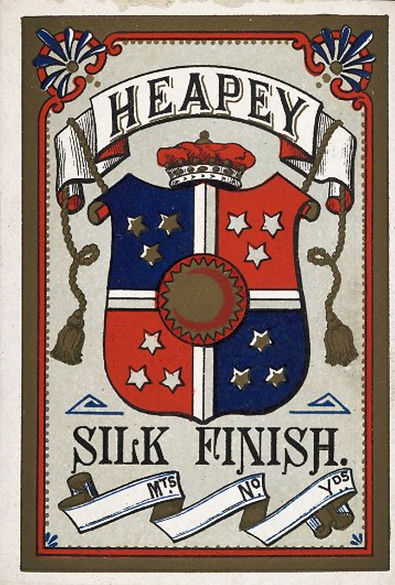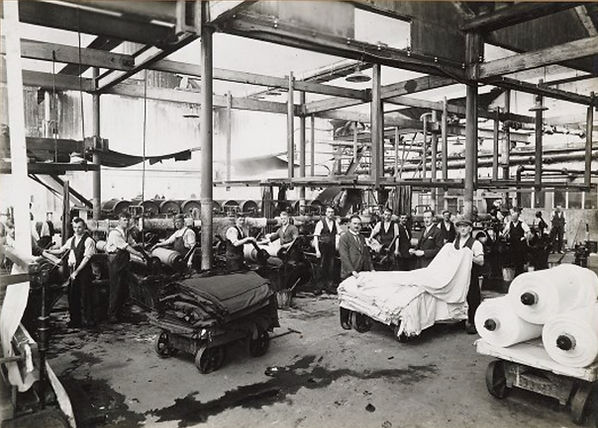
JOHN RYLANDS
Heapey Bleach Works

[Fig. 61]
Heapey Works in 1885.
Heapey Works near Chorley leasehold was signed in 1870. The warehouse produced bleached calico and became the biggest "bleaching and finishing works in Europe"[1].
To the workforce of approximately 300 employees, the main priority became the production of a high quality bleached calico, thus the company was publicly recognized for their "standard of excellence"[2]. According to D. A. Farnie, the firm "raised the standard of production of bleached calico even more than that of unbleached, being an advocate of pure rather than filled finishes, such as were produced by oversizing"[3]. The warehouse used vast resources of local water, approximately 4 million gallons daily but also it consisted of a greater amount of steam power than any other company had at that time, therefore the amount of coal utilized weekly totalled up to 370 tonnes.
[Fig. 62]
Heapey Finish - standart of excelence; Rylands & Sons example of trademark.
To access more trade mark samples of John Rylands, press the button below:
[Fig. 63]
Heapey Bleack Works.
Copyright of the University of Manchester

Heapey Bleach Works trademarks
[Map 19]
Location of Chorley in 1896.
[Fig. 64]
Heapey Bleach trademark.
Copyright of the University of Manchester.
[Fig. 65]
Heapey Bleach trademark.
Copyright of the University of Manchester.

[Fig. 66]
Heapey Bleach trademark.
Copyright of the University of Manchester.
Due to alterations in trade since 1890, the company began the withdrawal of many unprofitable warehouses, hence closing three mill schools at Heapey as well as Gorton and Wigan.
In 1953, Issac Wolfson was appointed as president of the firm and was determined to expand whole - sale of the business hence same year he sold the Mills[8].
The firm erected Heapey Bleach Works in 1895[4] and due to its considerable size, the economies of scale lead to the advantages of cheap production, increased manufacture and high profitability. The overhead costs were reduced by the supplemented variety of items the warehouse produced[5]. Furthermore, the warehouse "won a special reputation for its Dacca calicoes, for its bleached goods with their Heapey finish"[6]. The Mills focused mainly on dyeing and bleaching rather than calico printing and pioneered Longford Works. The production was always profitable this is due to the firm’s policy of securing its departments from the incidence of depression[7].
Inside of Heapey Bleach Works
[Fig. 67]
Employees of Heapey Works in singeing room. Picture taken from promotional brochure of Heapey Bleach in 1932.
Copyright of the University of Manchester.
[Fig. 68]
Bleaching department in 1932.
Copyright of the University of Manchester.
[Fig. 69]
Workforce of Heapey Bleach Works in 1932
Copyright of the University of Manchester.
[Fig. 70]
Production room at Heapey Bleach Works.
Copyright of the University of Manchester.
[Fig. 71]
Finishing room at Heapey Bleach Works. It is important to note, that within this department women labour becomes more apparent.
Copyright of the University of Manchester.
[Fig. 72]
Dyeing department at Heapey Works (1932)
Copyright of the University of Manchester.
[Fig. 73]
Dyeing department at Heapey Bleach Works in 1932.
Copyright of the University of Manchester.
[Fig. 74]
Steam power engines (1932)
Copyright of the University of Manchester.
[Fig. 75]
Laboratory at Heapey Works (1932)
Copyright of the University of Manchester.
[1]Farnie, D. A., John Rylands of Manchester (Manchester: John Rylands University Library, 1993), p. 17.
[2]John Rylands Library, Special Collections, RYL/1/3/2, Rylands & Sons sample trademarks, Heypey Finish Standart of Excellence.
[3]Farnie, D. A., John Rylands of Manchester (Manchester: John Rylands University Library, 1993), p. 17.
[4]Farnie, D. A., John Rylands of Manchester (Manchester: John Rylands University Library, 1993), Figure 7.
[5]Farnie, D. A., John Rylands of Manchester (Manchester: John Rylands University Library, 1993), p. 48.
[6]Farnie, D. A., John Rylands of Manchester (Manchester: John Rylands University Library, 1993), p. 48.
[7]Farnie, D. A., John Rylands of Manchester (Manchester: John Rylands University Library, 1993), p. 48.
[8]Farnie, D. A., John Rylands of Manchester (Manchester: John Rylands University Library, 1993), p. 76.












